Musculoskeletal conditions are common and involve most of the tissue types. Soft tissue mobilisation is a type of manual therapy administered by hand or with a rigid device. Instrument Assisted Soft Tissue Mobilisation (IASTM) is a technique which uses instruments to remove scar tissues and helps to facilitate healing in soft tissue injuries. Several IASTM tools and techniques are available to provide the soft tissue mobilisation. The purpose of this review article is to appraise evidence and show insight on history, mechanism and effects of IASTM. A literature search was conducted from PubMed, Embase, PEDro and Science Direct database journals to identify potential articles. Forty articles were identified, 32 articles were considered for the review. Based on the available case studies and experimental studies, IASTM can help the scar tissue mobilisation, musculoskeletal injuries. Still more articles and research must emerge to provide more evidence on IASTM.
Myofascial release,Musculoskeletal disorders,Myofascial tools,Soft tissue function
Introduction
Globally musculoskeletal conditions are leading cause of disability among all the age groups. Musculoskeletal conditions and injuries limit mobility and dexterity. These musculoskeletal pains occur throughout lifespan and involve most tissue types [1]. Connective tissue forms the single largest tissue component of the body. Fascia is one of the forms of connective tissue [2]. Myofascial pain syndrome is defined as sensory, motor and autonomic symptoms resulting from painful areas in the fascia surrounding skeletal muscle knows as myofascial trigger points [3]. Myofascial trigger points are palpable nodules which are taut bands of muscle fibres. These trigger points will compress the underlying structures and may elicit: a) motor dysfunction; b) local and referred tenderness; c) transient contraction of the muscle (local twitch response); and d) autonomic phenomena. Myofascial pain syndrome causes motion limitation, a palpable taut band with tenderness [4].
Musculoskeletal pain occur due to repetitive strain injuries. Sports injuries are also one of the reasons for it. When a person overexerts with high intensity exercise or long periods of exercise in poor posture, the soft tissues structures such as muscles, ligaments and tendons are more prone to injuries [5]. Rehabilitation after sports injuries is very important and several interventions have been proposed to help the healing process. These include electrotherapeutic modality treatment, cryotherapy, manual therapy, soft tissue mobilisation and exercise therapy.
Soft Tissue Mobilisation/Manipulation (STM) is a type of manual therapy which is frequently used by clinicians to reduce the pain and dysfunction associated with musculoskeletal conditions. On a daily basis 87% of clinicians are using manual therapy [6].
Recently, IASTM has drawn more attention for myofascial restriction based upon James Cyriax soft tissue mobilisation. Cyriax and Russell had employed this massage technique, in which deep friction technique is used to reach the musculoskeletal structures to provide therapeutic effect. Therapeutic application of technique is based on the evaluation of underlying structures [7]. Cyriax approach is applied with digital cross friction, whereas IASTM is a new technique in which new range of tools enables clinicians to efficiently locate and treat individuals diagnosed with soft tissue injuries, this technique helps in deeper penetration for specific region and helps in decreasing pain, increasing range of motion and improving function [8]. Different types of materials such as wood, ceramics, plastic, stone and stainless steel are used to make different brands of tools.
Historical Perspectives of IASTM
The ancient Egyptians and people of Mesopotania used tools made from bone, horn and metal to cleanse and massage the skin; those tools were called as Staves or Stringils. Later, Ancient Greeks and Romans also used Stringils to scrape skin and relax the muscles. To prevent skin irritation oil was used. Hawaii people used wooden implements “Lomi massage” for relieving the pain [9]. Greek people adopted stringils from romans who used the tools for treatment, few types like the slightly curved iron and right angle bent bronze stringils are present in British Museum [10]. [Table/Fig-1] shows some of the brands of IASTM [11].
| IASTM brands: |
|---|
| 1. Augmented Soft Tissue Mobilisation (ASTYM)2. Graston technique3. Gua Sha4. Fascial Abrasion Technique (FAT)5. Sound-Assisted Soft Tissue Mobilisation (SASTM) |
The ASTYM [Table/Fig-2] treatment process has three components: i) Initial step is to assess the entire kinetic movement pattern for the evaluation of any dysfunction, after identifying the dysfunction treating the specific structure to release the fibrosis; ii) stretching and strengthening exercises helps in improving the function and iii) detecting and reducing fibrosis which is the reason for movement restriction [12,13].
Graston technique was developed in 1990 for athletes. Chiropractors massage therapists and physical therapists are using these tools for the treatment of soft tissue related conditions [Table/Fig-3]. The Graston technique has certain protocol for treatment. It has different components: Screening of the area, warm up and IASTM application (30-60 seconds per session), followed by stretching and strengthening exercises. If inflammation is present apply cryotherapy [14]. The primary aim of IASTM is to increase myofascial mobility with less adverse effect such as bruising after treatment [15].
One of the brand of IASTM known as Gua Sha [Table/Fig-4]. It originated from ancient China. Gua Sha treatment used buffalo horns or jade stones. The main aim of this technique is to loosen the structures by applying pressure with different materials [16]. IASTM is the modified and ergonomically designed tools when compared to traditional soft tissue mobilisation such as Gua Sha.
Fascial Abrasion Technique (FAT) is applied by using a specialised tool which has ergonomically textured grip surface [Table/Fig-5]. It helps in loosening fascial tension, softens the structures, helps in reducing viscosity of tissues and stimulates blood flow and lymphatic circulation [11].
Sound Assisted Soft Tissue Mobilisation (SASTM) tools [Table/Fig-6] were developed by David, made of ceramic polymer. These tools also help in detecting adhesions and helps in breaking adhesions by minimising damage [17].
ASTYM tools [Hand drawn sketch].
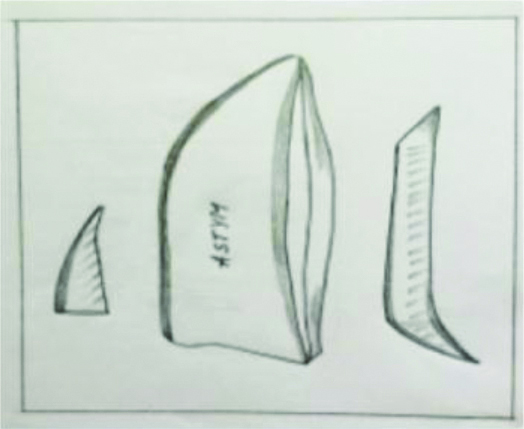
Graston tools [Hand drawn sketch].
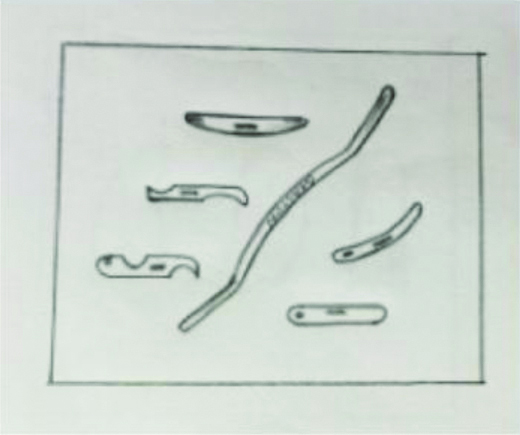
Gua Sha tools [Hand drawn sketch].
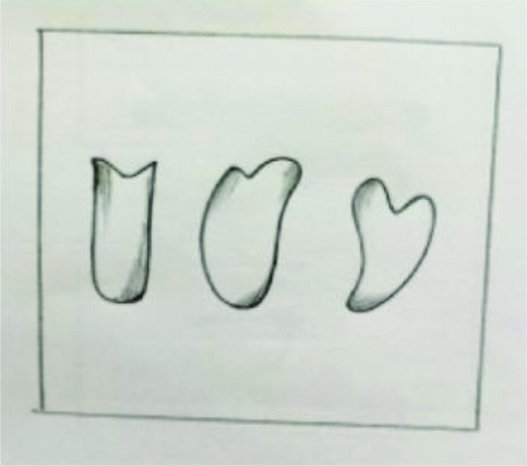
FAT tools [Hand drawn sketch].
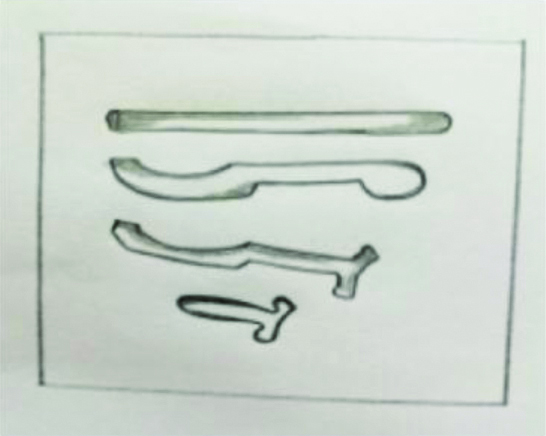
SASTM tools [Hand drawn sketch].
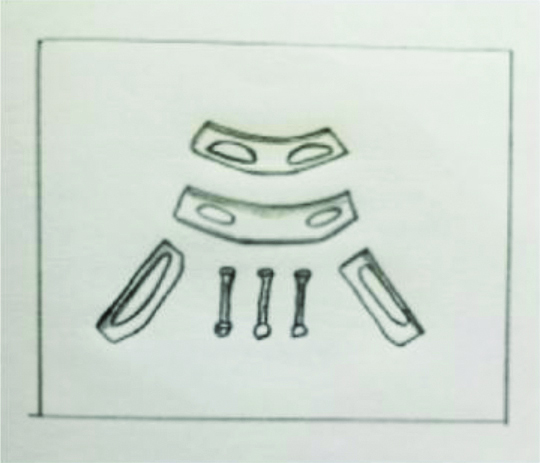
There are various companies which make IASTM tools. Edge tool and Kinesio tool are example of IASTM tool [Table/Fig-7,8]. Different brands are listed in [Table/Fig-9].
Edge tool [Photo taken by author].
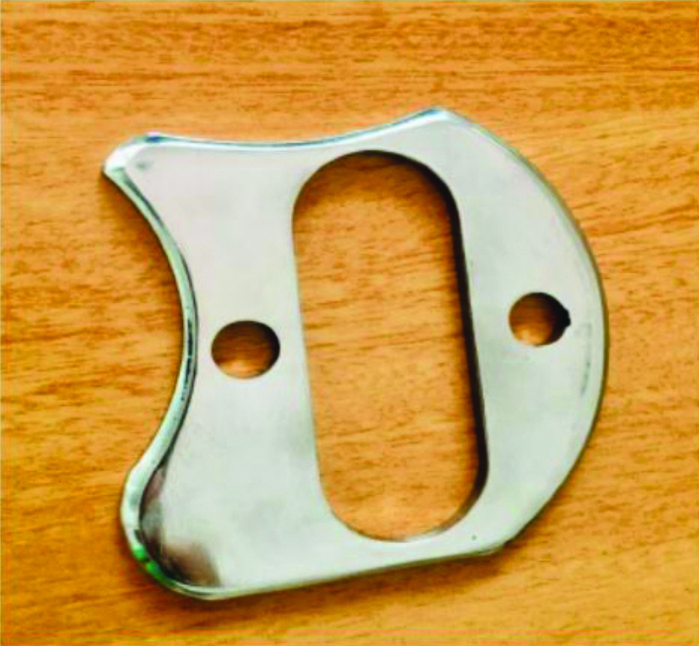
Kinesio IASTM tool [Photo taken by author].
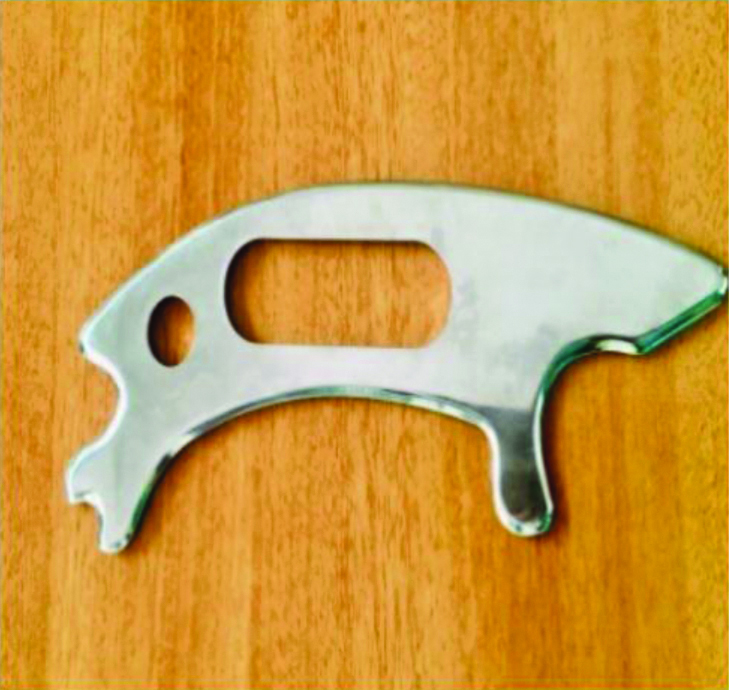
| Type of IASTM | Material’s used as instrument | Theory behind the method | Method of application | Reaction |
|---|
| Augmented Soft Tissue Mobilisation (ASTYM) [12] | Hard, acrylic plastic tools are used to glide the tissue. | Stimulates regeneration | Glides | Redness, bruising, micro trauma |
| Graston technique [14] | Stainless steel tools | Breaking up adhesions | Deep, rhythmic pressure | Redness, bruising, micro trauma |
| Gua sha [16] | Plastic, Stone/Steel | Redness, heat | Scraping | Redness, bruising, micro trauma |
| Fascial abrasion technique [11] | Textured finish tool patented by Dr. Mark Scappaticci | Releases fascial tension | Mobilises fascia | Controlled Micro trauma |
| Sound assisted soft tissue mobilisation [17] | Ceramic polymer tools | Breaks fascial restriction and scar tissue | Feels adhesions by mobilising with tool | Micro trauma |
In chronic soft tissue injuries scar tissue and adhesions are formed during the process of healing. Scar tissue and adhesion will limit the motion by preventing the tissue lengthening, elasticity and causes pain [18]. Excessive new cells will be laid underlying the scar tissue in a haphazard manner. In IASTM technique instrument application will give mechanical advantage for the clinicians to apply a deeper penetration pressure by increasing vibration sense for a specific treatment area, which will reduce the stress pressure on hands of clinicians [Table/Fig-10].
Instrument assisted soft tissue mobilisation for lateral epicondylitis and tendoachillis [Photos taken by author].
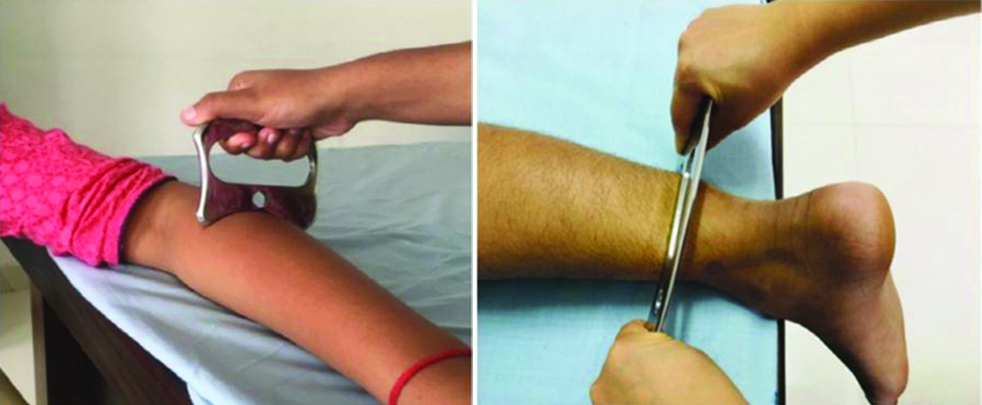
Mechanism of IASTM application.
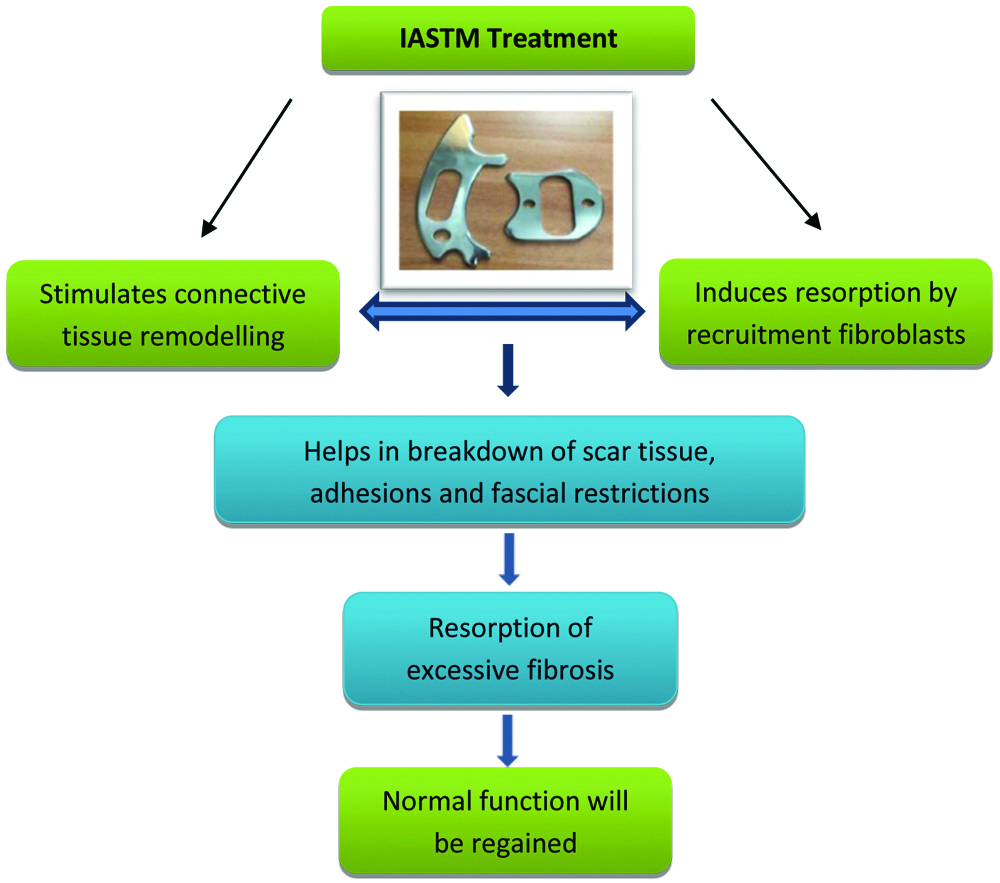
IASTM treatment helps in repair by excessive fibrosis resorption and collagen regeneration. It improves oxygen and nutrients supply to tissue by stimulating connective tissue remodelling. In turn, it will help in scar tissue, adhesions and fascial restrictions breakdown. In animal studies on rats with enzyme induced tendinitis, the use of instruments is evident in increasing fibroblasts proliferation and collagen repair. As scar tissue is removed by IASTM, normal functions will be achieved around the structures. Micro vascular and capillary haemorrhage, localised inflammation occurs as a result of pressure by IASTM. This inflammation stimulates the healing process by releasing adhesions, which in turn increase the blood and nutrient supply to the injured area and migration of fibroblasts. Finally, the regeneration of injured tissues will be enabled by forming a new collagen [8,19].
Effects of IASTM
The efficacy of IASTM was described by case reports since many years. Most of the case reports reported successful and effective treatment of IASTM for tendinopathies and arthrofibrosis. The effect of IASTM on various musculoskeletal conditions were reported, such as the effects of IASTM on various musculoskeletal conditions.
Discussion
The present review study was done with the objective of finding the efficiency of IASTM for different musculoskeletal conditions. Following injuries the soft tissue function will diminish and makes it difficult to participate in daily activities. IASTM efficacy has been studied in relation to different types of musculoskeletal injuries. Different research studies have explained the positive effects of IASTM. The main aim of IASTM technique is to remove the scar tissue, facilitate the regeneration process with the help of pressure application by ergonomically suitable tool. As scar tissue limits the mobility of the injured soft tissue, the oxygen supply will be reduced; collagen formation may lead to decreased functional mobility. With the help of IASTM fibroblasts proliferation and collagen repair is evident in studies [19].
Gehlsen GM et al., stated that with the application of high pressure ASTM for 3 minutes for total six treatment sessions, it showed the development of fibroblasts in Achilles tendon injury [20]. Hammer WI and Prefer MT described the effective application of Graston Technique on a 59-year-old patient with superficial and deep fascia. The patient was asymptomatic and showed significant improvement in range of motion of extensors and hamstrings after 6 sessions of treatment [21].
Loghmani MT and Warden SJ, studied the effectiveness of Instrument Assisted Cross Fibre Message (IACFM) on animals and found the effectiveness of it. IACFM accelerates the healing process by helping in collagen formation [22]. Bayliss AJ et al., stated that nine sessions of IASTM approach, soft tissue mobility, pain, calf strength and lower functional scale scores were improved and pain symptoms reduced [23]. Braun M et al., stated that effectiveness of Gua Sha intervention for chronic neck pain. The treatment showed improvement in reducing pain on Neck disability index and quality of life improved [24]. Schaefer JL and Sandrey MA, reported that Graston technique showed improvement in dynamic postural control, range of motion, pain and disability improved in dynamic balance training for chronic ankle pain [25]. Laudner K et al., study concluded the application of IASTM to the posterior shoulder, helped in improving the glenohumeral horizontal adduction range of motion and internal rotation range of motion [26]. Lee JJ et al., stated the improvement of neuromuscular imbalance between tendoachilles and gastrocnemius muscle activation with the application of IASTM [27].
Sevier TL and Stegink-Jansen CW, conducted a study on 107 subjects; study suggested the effectiveness of ASTYM for lateral epicondyle tendinopathy condition [12]. Davis CC et al., analysed 40 women with the complications of post mastectomy. Lymphatic drainage along with ASTYM showed effective results [28]. Motimath B et al., conducted a study on 50 subjects with unilateral trapezius spasm. IASTM M2T blade technique was used to reduce the spasm in trapezitis condition. Reports showed the immediate reduction in pain [29]. Stanek J et al., conducted a study on 44 active participants with less than 30° of dorsi flexion. Control, compressive myofascial release and Graston technique, three groups were made. Both the group subjects received 5 minute treatment. Compressive myofascial release increased the dorsi flexion range of motion [30]. Cheatham SW was able to show the effective result of light pressure IASTM immediately for delayed onset of muscle soreness on quadriceps muscle [31]. The side effect of IASTM is bruising and soreness. It’s a response which occurs after treatment in soft tissues. It can be reduced by cryotherapy following IASTM application [22]. [Table/Fig-12] shows different studies for IASTM.
Clinical implications of IASTM [12,20-31].
| Sl. No. | Author | Year of the study | Condition | Technique | Remarks |
|---|
| 1. | Gehlsen GM, [20] | 1999 | Achilles tendon | Augmented Soft Tissue Mobilisation (ASTM) | Study concluded with the evidence of fibroblasts development by the application of high pressure ASTM for 3 minutes for a total of six treatment sessions. |
| 2. | Hammer WI and Pfefer MT, [21] | 2005 | Sub-acute lumbar compartment syndrome | Graston Technique (GT) | A 59-year-old patient superficial and deep fascia was evaluated and treated by GT. After 6 visits at two visits per week the patient was asymptomatic and showed significant improved range of motion of right extensors and hamstrings. |
| 3. | Loghmani MT and Warden SJ, [22] | 2009 | Knee ligament injury | Instrument Assisted Cross Fibre Message (IACFM) | This research study on animals was a practical technique to find the effect of IACFM. It concludes IACFM accelerates healing by helping in collagen formation and organisation. |
| 4. | Bayliss AJ et al., [23] | 2011 | Chronic calf pain | Instrument Assisted Soft Tissue Mobilisation (IASTM) | After nine sessions of IASTM approach, soft tissue mobility, pain, calf strength and lower functional scale scores were improved and her pain symptoms were abolished. |
| 5. | Braun M et al., [24] | 2011 | Chronic neck pain | Gua Sha | Gua Sha intervention showed a significant improvement in reducing pain on Neck disability index and quality of life improved. |
| 6. | Schaefer JL and Sandrey MA, [25] | 2012 | Effect of Dynamic Balance Training (DBT) for chronic ankle instability | Graston technique (GIASTM) | Pre-test and post test results states for chronic ankle instability subjects shows improvement in dynamic postural control, range of motion, pain and disability improved in DBT/GIASTM intervention group and largest effects were found. |
| 7. | Laudner K et al., [26] | 2014 | On baseball players to improve posterior shoulder ROM. | Instrument assisted Soft tissue mobilisation (IASTM) | Study on baseball players concluded the application of IASTM to the posterior shoulder gave acute improvements in both glenohumeral horizontal adduction range of motion and internal rotation range of motion. |
| 8. | Lee JJ et al., [27] | 2014 | To inhibit hypertonic muscles | Instrument Assisted Soft Tissue Mobilisation (IASTM) | The study showed a promising improvement of neuromuscular imbalance between TA and GCM muscle activations. |
| 9. | Sevier and Stegink-Jansen CW, [12] | 2015 | Chronic lateral epicondyle tendinopathy | Augmented Soft Tissue Mobilisation (ASTM) | 107 subjects were randomly assigned and study suggested ASTYM treatment is effective to treat LE tendinopathy patients. |
| 10. | Davis CC et al., [28] | 2016 | Scar complications post mastectomy | Along with ASTYM manual lymphatic drainage was used | 40 women were analysed. Results shown evidence of effectiveness. |
| 11. | Motimath B er al., [29] | 2017 | Spasm in trapezitis | IASTM with M2T blade technique to reduce the spasm in trapezitis. | 50 subjects with unilateral trapezius spasm were included, visual analogue scale was taken as outcome measure before and after intervention. VAS showed decreased values after treatment. Study reported as IASTM is an effective tool in reducing pain immediately. |
| 12. | Stanek J et al., [30] | 2018 | Dorsiflexion range of motion | Compressive Myofascial Release (CMR) and IASTM using Graston technique | 44 active participants were selected who has less than 30° of DF. Three groups were made: control, CMR and GT. Both groups received 5-minute treatment that included scanning the area and treating specific restrictions. Standing, kneeling ankle dorsiflexion was measured before and immediately after treatment. Compressive MFR increased ankle DF after single treatment. |
| 13. | Cheatham SW [31] | 2019 | Delayed onset of muscle soreness | IASTM with Rock Blades (Mohawk tool) | 23 active adults were taken as sample. Pressure Pain Threshold (PPT) testing, Two Point Discrimination (TPD) are the outcome measures. Light pressure IASTM treatment was applied for delayed onset of muscle soreness on quadriceps muscles, results showed effectiveness of technique on specific muscle. |
The various researchers tried to imply the practical application of IASTM on different musculoskeletal and sports specific conditions. Review of the articles, suggests the effectiveness of the technique in chronic neck pain, back pain, spasm, tendinitis, soreness and tendinopathies. Contraindications are bleeding disorders, deep vein thrombosis, lymphedema, myositis ossificans, osteoporosis, open wounds and infections. This technique had shown the results in increasing range of motion, reducing pain, improving neuromuscular balance, accelerating healing and postural control. In future, randomised control trails and experimental research studies need to be done more, to give additional evidence on the effectiveness of IASTM for soft tissue release.
Conclusion
IASTM is a simple and practical technique in which special instruments are used to remove scar tissue and helps in the process of healing by activating fibroblasts. According to few case studies, experimental studies, IASTM was found to improve range of motion in acute and chronic injuries, also decreases pain. Most of the studies were case studies rather than randomised control trials. Strong evidence levels were yet to be established. Therefore, the scientific research must be done in a broader aspect to reflect the positive significant of the IASTM.
[1]. United news of India. Musculoskeletal conditions, second largest contributor to disability worldwide/science technology/news. 2018; accessed 05/20/19 [Google Scholar]
[2]. Chaitow L, Modern neuromuscular technique 2003 2nd EditionEdinburghChurchill Livingstone [Google Scholar]
[3]. Baldry PE, Acupuncture, trigger points, and musculoskeletal pain 2004 3rd editionChurchill Livingstone10.1016/B978-044306644-3.50005-X [Google Scholar] [CrossRef]
[4]. Bron C, Dommerholt JD, Etiology of myofascial trigger points Current pain headache Reports 2012 16:439-44.10.1007/s11916-012-0289-422836591 [Google Scholar] [CrossRef] [PubMed]
[5]. Hart LE, Exercise and soft tissue injury Baillieres Clinical Rheumatology 1994 8:137-48.10.1016/S0950-3579(05)80228-6 [Google Scholar] [CrossRef]
[6]. Karels C, Polling W, Bierma-Zeinstra S, Treatment of arm, neck, and/or shoulder complaints in physical therapy practice Spine 2006 31:E584-89.10.1097/01.brs.0000229229.54704.7716924196 [Google Scholar] [CrossRef] [PubMed]
[7]. Chamberlain GJ, Cyriax’s friction massage: A review The Journal of Orthopaedic and Sports Physical Therapy 1982 4:16-22.10.2519/jospt.1982.4.1.1618810110 [Google Scholar] [CrossRef] [PubMed]
[8]. Baker RT, Nasypany A, Seegmiller JG, Baker JG, Instrument assisted soft tissue mobilization treatment for tissue extensibility dysfunction International Journal of Athletic Therapy and Training 2013 18(5):16-21.10.1123/ijatt.18.5.16 [Google Scholar] [CrossRef]
[9]. Myofascialcorrection.com/about/iastm-history/accessed 04/15/2019 [Google Scholar]
[10]. Flinders Petrie WM, Tools and weapons illustrated by the Egyptian collection in university college, London and 2000 outlines from other is 1916 [Google Scholar]
[11]. Markovic G, Acute effects of instrument assisted soft tissue mobilization vs foam rolling on knee and hip range of motion in soccer players. Journal of Body work and Movement Therapies 2015 19:690-96.10.1016/j.jbmt.2015.04.01026592226 [Google Scholar] [CrossRef] [PubMed]
[12]. Sevier TL, Stegink-Jansen CW, Astym treatment vs. eccentric exercise for lateral elbow tendinopathy: A randomized controlled clinical trial Peer J 2015 3:e96710.7717/peerj.96726038722 [Google Scholar] [CrossRef] [PubMed]
[13]. Davies CC, Brockopp DY, Use of ASTYM® treatment on scar tissue following surgical treatment for breast cancer: A pilot study Rehabilitation Oncology 2010 28(3):03-12.10.1097/01893697-201028030-00001 [Google Scholar] [CrossRef]
[14]. Technique G, Graston Technique: Frequently Asked Questions Graston Technique Website 2016 available at: http://www.grastontechnique.com/FAQs.html. Accessed 6/21/19 [Google Scholar]
[15]. Lauche R, Wubbeling K, Ludtke R, Cramer H, Choi KE, Randomized controlled pilot study: Pain intensity and pressure pain thresholds in patients with neck and low back pain before and after traditional East Asian “Gua Sha” therapy The American Journal of Chinese Medicine 2012 40(05):905-17.10.1142/S0192415X1250067X22928824 [Google Scholar] [CrossRef] [PubMed]
[16]. Nielsen A, Knoblauch NT, Dobos GJ, Michalsen A, Kaptchuk TJ, The effect of Gua Sha treatment on the microcirculation of surface tissue: a pilot study in healthy subjects Explore (New York, N.Y.) 2007 3:456-66.10.1016/j.explore.2007.06.00117905355 [Google Scholar] [CrossRef] [PubMed]
[17]. Sound assisted soft tissue mobilization. Why choose sastm/accessed 06/25/19 [Google Scholar]
[18]. Huard J, Li Y, Fu FH, Muscle injuries and repair: current trends in research The Journal of Bone and Joint Surgery. American Volume 2002 84-A:822-32.10.2106/00004623-200205000-00022 [Google Scholar] [CrossRef]
[19]. Davidson CJ, Ganion LR, Gehlsen GM, Verhoestra B, Roepke JE, Sevier TL, Rat tendon morphologic and functional changes resulting from soft tissue mobilization Medicine and Science in Sports and Exercise 1997 29(3):313-19.10.1097/00005768-199703000-000059139169 [Google Scholar] [CrossRef] [PubMed]
[20]. Gehlsen GM, Ganion LR, Helfst R, Fibroblast responses to variation in soft tissue mobilization pressure Medicine and Science in Sports and Exercise 1999 31(4):531-35.10.1097/00005768-199904000-0000610211847 [Google Scholar] [CrossRef] [PubMed]
[21]. Hammer WI, Pfefer MT, Treatment of a case of subacute lumbar compartment syndrome using the Graston technique Journal of Manipulative and Physiological Therapeutics 2005 28(3):199-204.10.1016/j.jmpt.2005.02.01015855909 [Google Scholar] [CrossRef] [PubMed]
[22]. Loghmani MT, Warden SJ, Instrument-assisted cross-fiber massage accelerates knee ligament healing The Journal of Orthopaedic and Sports Physical Therapy 2009 39(7):506-14.10.2519/jospt.2009.299719574659 [Google Scholar] [CrossRef] [PubMed]
[23]. Bayliss AJ, Klene FJ, Gundeck EL, Loghmani MT, Treatment of a patient with post-natal chronic calf pain utilizing instrument assisted soft tissue mobilization: a case study Journal of Manual and Manipulative Therapy 2011 19(3):127-34.10.1179/2042618611Y.000000000622851875 [Google Scholar] [CrossRef] [PubMed]
[24]. Braun M, Schwickert M, Nielden A, Brunnhuber S, Dobos G, Effectiveness of traditional Chinese “Gua Sha” therapy in patients with chronic neck pain: A randomized Controlled Trial Pain Medicine 2011 12:362-69.10.1111/j.1526-4637.2011.01053.x21276190 [Google Scholar] [CrossRef] [PubMed]
[25]. Schaefer JL, Sandrey MA, Effects of 4-week dynamic balance training program supplemented with Graston instrument assisted soft tissue mobilization for chronic ankle stability Journal of Sport Rehabilitation 2012 21(4):313-26.10.1123/jsr.21.4.31323118072 [Google Scholar] [CrossRef] [PubMed]
[26]. Laudner K, Compton BD, McLoda TA, Walters CM, Acute effects of instrument assisted soft tissue mobilization for improving posterior shoulder range of motion in collegiate baseball players International Journal of Sports Physical Therapy 2014 9(1):01-07. [Google Scholar]
[27]. Lee JJ, Lee JJ, Kim do H, You SJ, Inhibitory effects of instrument-assisted neuromobilization on hyperactive gastrocnemius in a hemiparetic stroke patient Bio-Medical Materials and Engineering 2014 24(6):2389-94.10.3233/BME-14105225226939 [Google Scholar] [CrossRef] [PubMed]
[28]. Davis CC, Brockopp D, Moe K, Astym therapy improves function and range of motion following mastectomy Breast Cancer (Dove press) 2016 8:39-45.10.2147/BCTT.S10259827022302 [Google Scholar] [CrossRef] [PubMed]
[29]. Motimath B, Ahammed N, Chivate D, Immediate effect of instrument assisted soft tissue mobilization (IASTM) with M2T blade technique in trapezitis: An experimental study International Journal of Applied Research 2017 3(5):527-29. [Google Scholar]
[30]. Stanek J, Sullivan T, Davis S, Comparison of compressive myofascial release and the Graston technique for improving ankle dorsiflexion range of motion Journal of Athletic Training 2018 53(2):160-67.10.4085/1062-6050-386-1629373060 [Google Scholar] [CrossRef] [PubMed]
[31]. Cheatham SW, Does a light pressure instrument assisted soft tissue mobilization technique modulate tactile discrimination and perceived pain in healthy individuals with DOMS? Journal of Canadian Chiropractic Association 2019 63(1):18-25. [Google Scholar]